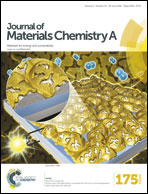The mixed alloyed chemical composition of chloro-(chloro)n-boron subnaphthalocyanines dictates their physical properties and performance in organic photovoltaic devices†
Abstract
Chloro-boron subnaphthalocyanine (Cl-BsubNc) has recently attracted significant interest as a light-harvesting and charge transporting material in organic photovoltaic devices (OPVs) by enabling an 8.4% efficient planar heterojunction OPV cell. We present herein a variety of experimental data that supports the conclusion that Cl-BsubNc, whether synthesized via literature methods or our in-house methods or purchased commercially, is actually a mixed alloyed composition of Cl-BsubNcs with random amounts of chlorination at the bay position(s) of the BsubNc macrocyclic structure which we hereafter will refer to as Cl–ClnBsubNc(s). We outline our efforts to develop alternative chemical processes, whereby we did obtain samples with lower and higher amounts of bay position chlorination. However, we were unable to obtain a pure, non-bay chlorinated sample of Cl-BsubNc. The positions and frequencies of the peripheral chlorine atoms were determined via single crystal X-ray crystallography of two different mixed alloyed compositions of Cl–ClnBsubNc samples and MS and XPS analysis of all Cl–ClnBsubNc samples. The photo- and electro-physical properties were found to differ amongst the Cl–ClnBsubNc samples with varying amounts of chlorination. These differences also translated into varying performance within planar heterojunction OPVs, whereby a mixture of Cl–ClnBsubNcs with lower amounts of chlorination produced less efficient OPVs (albeit with a higher open circuit voltage) compared to a mixture with higher amounts of chlorination. Additionally, an in-house made sample of Cl–ClnBsubNc, with the highest level of bay position chlorination, yielded the best performing OPVs through an improved fill factor. A commercial sample of Cl–ClnBsubNc also yielded OPVs with efficiencies equivalent to a Cl–ClnBsubNc sample prepared in our laboratory. This mixture of Cl–ClnBsubNcs is therefore likely to be present in the reported 8.4% efficient OPV device. Our results therefore offer a cautionary note that the Cl-BsubNc samples used within the existing literature are likely not a pure chemical composition but are rather mixtures of Cl–ClnBsubNcs with bay position chlorination. Our findings clarify the previous literature results on the chemistry of Cl-BsubNc, firm up the photo- and electro-physical properties of these materials, and offer additional insight into their application as functional materials in efficient OPVs.


 Please wait while we load your content...
Please wait while we load your content...